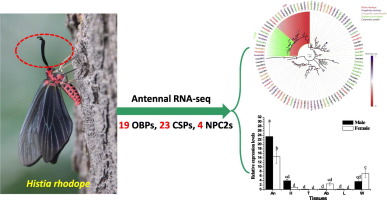当前位置:
X-MOL 学术
›
Comp. Biochem. Physiol. D Genom. Proteom.
›
论文详情
Our official English website, www.x-mol.net, welcomes your
feedback! (Note: you will need to create a separate account there.)
Antennal transcriptome analysis and expression profiles of putative chemosensory soluble proteins in Histia rhodope Cramer (Lepidoptera: Zygaenidae).
Comparative Biochemistry and Physiology D: Genomics & Proteomics ( IF 2.2 ) Pub Date : 2020-01-11 , DOI: 10.1016/j.cbd.2020.100654 Haibo Yang 1 , Junfeng Dong 1 , Yalan Sun 1 , Zhenjie Hu 1 , Qihui Lv 1 , Dingxu Li 1
Comparative Biochemistry and Physiology D: Genomics & Proteomics ( IF 2.2 ) Pub Date : 2020-01-11 , DOI: 10.1016/j.cbd.2020.100654 Haibo Yang 1 , Junfeng Dong 1 , Yalan Sun 1 , Zhenjie Hu 1 , Qihui Lv 1 , Dingxu Li 1
Affiliation

|
Histia rhodope Cramer (Lepidoptera: Zygaenidae) is one of the most destructive defoliators of landscape tree Bischofia polycarpa (Levl.) Airy Shaw in China stretching to other Southeast Asia regions. Olfactory genes, encoding proteins such as odorant carrier proteins believed to initiate olfactory signal transduction in insects, have been acknowledged to be novel targets for pest control. In this study, we established antennal transcriptome of H. rhodope and ultimately identified 19 odorant binding proteins (OBPs), 23 chemosensory proteins (CSPs) and 4 Niemann-Pick type C2 proteins (NPC2s). The 19 OBPs, 6 CSPs and 4 NPC2s were assessed to validate the differential expressions between sexes, and between olfactory and non-olfactory tissues. 8 OBPs and 2 CSPs exhibited male-biased antennae expression, while 6 OBPs, 2 CSPs and HrhoNPC2a exhibited female-biased antennae expression. Moreover, 17 OBPs, 4 CSPs and 2 NPC2s were predominantly expressed in the antennae compared with non-olfactory tissues. HrhoOBP1 and HrhoOBP8 were predominantly expressed in the antennae and heads, HrhoCSP8 and HrhoCSP14 were highly expressed in abdomens and legs, HrhoNPC2c was highly expressed in abdomens, while HrhoNPC2d was expressed in all tissues. Phylogenetic analysis revealed that most H. rhodope proteins were closely related to proteins from other moths. Moreover, compared with other nocturnal moths, acting as a diurnal moth, we found that H. rhodope may have lost a PBP gene. Our results provide important molecular information for further studies on olfactory mechanisms of H. rhodope.
更新日期:2020-01-13









































 京公网安备 11010802027423号
京公网安备 11010802027423号